Workshop on Blue Parks, 7 March 2024
Andrea Strachinescu-Olteanu of DG MARE, European Commssion opened the workshop reminding participants that the current Commission was very interested in marine protected areas (MPAs) as a means to help restore the battered ocean. So long as Horizon Europe, the large research framework programme was running, there would be funding to this goal. It was important to show results to increase chances that these commitments would be sustained by future decision makers and programmes.
Gregory Fuchs of the MIP Ocean platform recalled some of the conclusions of a preparatory workshop in December 2023. Despite having declared 12% of European waters as protected, less than one % were effectively so, the other 11% or so were mere paper parks. It was important to stand together for changing this in order to make sure the societal benefits of truly functioning marine parks would become to decision makers and ordinary citizens alike, working on the identified levers.
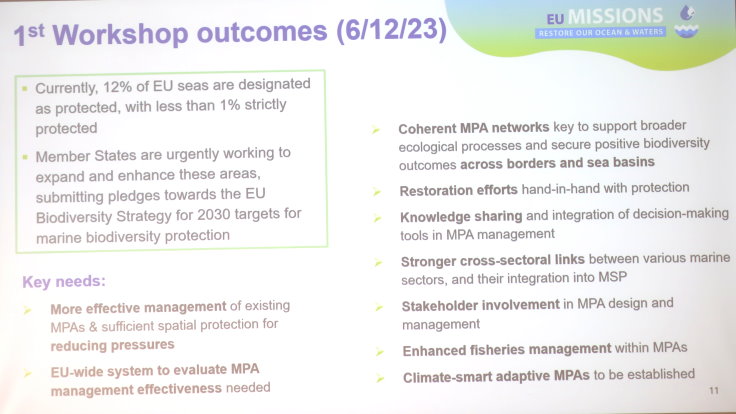
Alberto Zocchi of CINEA, the executive agency for many projects contributing to Mission 'Restore our Ocean and Rivers' established in 2021, provided an overview. He helped participants focused on the action to navigate a few key policy objectives and the major implementation tools. According to the EU Biodiversity Strategy adopted in support of the UN Agenda 2030 with the Sustainable Development Goals (SDGs), the Aichi targets under the Convention of Biological Diversity (CBD) and the recently adopted Global Biodiversity Framework 30% of European lands and seas should be protected by 2030. Of these, 10% should be strictly protected.
Five missions had been negotiated to addres major societal objectives and using all kinds of implementation mechanisms from European to local levels. The mission 'Restore European Ocean and Waters by 2030' was one of the five. In four major sub-regions lighthouses were sites to pilot and demonstrate possible solutions for restoring badly degraded ecosystems in a socially and economically sustainable manner. Among the major funding instruments figured the Horizon Europe research and innovation framework programme, LIFE, the EU's funding instrument for the environment and climate action programme, and EMFAF, the European Maritime, Fisheries and Aquaculture Fund supporting the Common Fisheries Policy. An assessment report of some 800 projects funded during the period 2013 to 2023 allowed to identify gaps and should help to direct resources and activities accordingly.
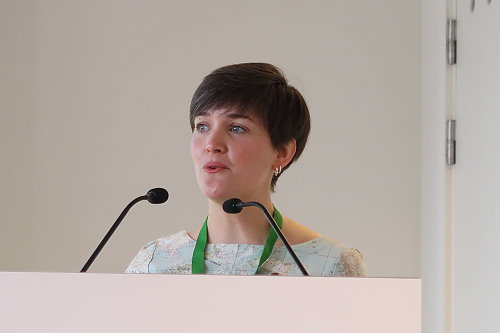 With the scene set like this, most of the remaining day was spent on learning from project leaders how they were approaching the restoration mandate and what experiences they had gathered so far. A recurrent concern was that for restoration to have a chance, the excessive pressures needed to be reduced that had led to the environmental degradation in social and economic problems in its wake. As one speaker remarked: when the house is burning, you can not rebuild it, you first need to extinguish the fire. Among the many interesting reports, we can mention only a few and need to take their preliminary findings with a pinch of salt as most projects were not even half way through their programme.
With the scene set like this, most of the remaining day was spent on learning from project leaders how they were approaching the restoration mandate and what experiences they had gathered so far. A recurrent concern was that for restoration to have a chance, the excessive pressures needed to be reduced that had led to the environmental degradation in social and economic problems in its wake. As one speaker remarked: when the house is burning, you can not rebuild it, you first need to extinguish the fire. Among the many interesting reports, we can mention only a few and need to take their preliminary findings with a pinch of salt as most projects were not even half way through their programme.
Jannica Haldin, project coordinator at HELCOM, the Baltic Marine Environment Protection Commission based in Helsinki, Finland, was seven months into her stint of 7 years. She was already reeling under the multiple layers of mismatching national rules, local interests and continuously increasing pressures on the environment. These pressures were primarily unbridled agricultural run-off increasing dead zones, excessive fishing leading to collapses e.g. of Western Baltic cod and herring populations, poisoning from rusting containers of WWII ammunition, ghost nets on ship wrecks and more. Tourism had increased by 40% in the last decade, but could become even more significant, if the environment was in a better state. In her contagiously friendly and energetic way, she highlighted that it was most promising to woth with those who had most to gain directly from a healthy Baltic and would be willing to support legislation that would enforce measures reducing harm. Her key message was: it is best to do many simple things so that benefits become visible and thus get more people and organisations to engage.
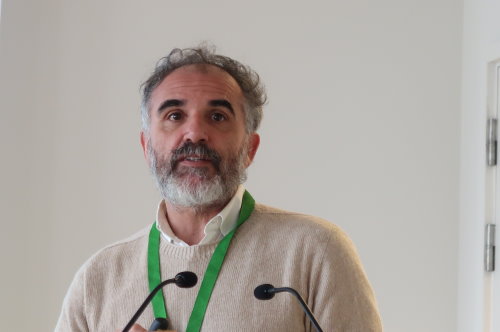 Lorenzo Bramanti of LECOB-CNRS in France argued for more science in decision-making to enhance cost-effectiveness. He illustrated the point with an example about increasingly popular artificial reefs both to restore habitats destroyed by heavy bottom trawling and in other areas as habitat diversification for marine species. They were most effective if placed in areas with currents, the highways of larval and plankton transport. Careful siting of protection should focus on functional ecosystem units, not isolated species, even if such iconic species might help communication with the public. He cautioned that oversimplification for expediency in communication with citizens or politicians could backfire. It was important to accept and embrace complexity and time for recovery as key features of ecosystems to regain robustness. In brief, marine conservation and recovery were to be based on science-based protocols with a focus on securing benefits for citizens to ensure social consensus and support.
Lorenzo Bramanti of LECOB-CNRS in France argued for more science in decision-making to enhance cost-effectiveness. He illustrated the point with an example about increasingly popular artificial reefs both to restore habitats destroyed by heavy bottom trawling and in other areas as habitat diversification for marine species. They were most effective if placed in areas with currents, the highways of larval and plankton transport. Careful siting of protection should focus on functional ecosystem units, not isolated species, even if such iconic species might help communication with the public. He cautioned that oversimplification for expediency in communication with citizens or politicians could backfire. It was important to accept and embrace complexity and time for recovery as key features of ecosystems to regain robustness. In brief, marine conservation and recovery were to be based on science-based protocols with a focus on securing benefits for citizens to ensure social consensus and support.
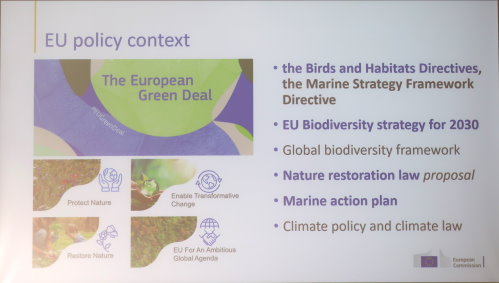 Vedran Nikolić of the Nature Conservation Unit in Directorate General Environment of the European Commission is a veteran of negotiations at different levels, in Europe and globally, around the Convention on Biological Diversity (CBD). He noted the large implementation gap between ambitions in the treaties and the ground realities. Failed implementation made species first become very rare and then go extinct. He recognised that it takes time to engage citizens, but that it was imperative to speed such engagement up significantly. In Europe some 6000 marine protected areas (MPAs) were declared, half of them Natura 2000 sites, but their current state and management effectiveness were not systematically assessed. With no outcome indicators nobody had a good overview.
Vedran Nikolić of the Nature Conservation Unit in Directorate General Environment of the European Commission is a veteran of negotiations at different levels, in Europe and globally, around the Convention on Biological Diversity (CBD). He noted the large implementation gap between ambitions in the treaties and the ground realities. Failed implementation made species first become very rare and then go extinct. He recognised that it takes time to engage citizens, but that it was imperative to speed such engagement up significantly. In Europe some 6000 marine protected areas (MPAs) were declared, half of them Natura 2000 sites, but their current state and management effectiveness were not systematically assessed. With no outcome indicators nobody had a good overview.
He also insisted that it was essential to reduce human pressures not only in protected areas, but also beyond the 30% supposed to become protected under international and regional agreements. These not formally protected areas needed to be managed for sustainability and not being mined, if the overall results were to be achieved. He was unwavering in this expectation that the new European nature restoration law had the hallmarks of a game changer, even after some watering down in the last steps through the European Parliament and negotiations with the EU Member States. His final affirmation was an encouragement to do more and reap the benefits: reduce pressures on nature and you'll see some early recovery signs.
In discussions during breaks Mundus maris drew attention to a new role play on how to make a potentially contested Marine Protected Area work in a fictitious country. Such a role play is the main assignment of our current intern, Monica Facci, a master student in environmental humanities at Cà Foscari University in Venice. Taking advantage of the experience in the audience and through interviews with different stakeholders, she will develop the material for the characters that young adults in schools or universities can impersonate to gain some knowledge about protecting biodiversity and different positions vis-à-vis MPAs. Equally important is also the emotional exposure during a moderated respectful deliberation to develop a social consensus. After testing, the material will be available to those wanting e.g. to perform the role play for World Ocean Day, 8 June or any other occasion. Contact info[a]mundusmaris.org.
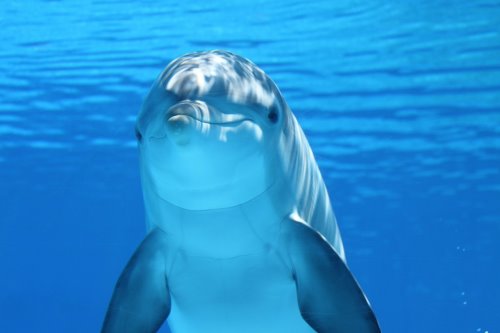 Several speakers illustrated that overlapping sectoral legislation represented formidable obstacles to more integrated rules which could strike a better balance for people and nature between costs and benefits. From all regions across Europe speakers brought similar messages and experiences: engage with municipalities, fishers, ordinary citizens, with all those who are affected by ocean health. Knowledge is necessary, but not sufficient. We need engagement of hearts and minds. Start with stopping or reducing pressures, find solutions to restore local habitats, show the benefits of a healthy environment.
Several speakers illustrated that overlapping sectoral legislation represented formidable obstacles to more integrated rules which could strike a better balance for people and nature between costs and benefits. From all regions across Europe speakers brought similar messages and experiences: engage with municipalities, fishers, ordinary citizens, with all those who are affected by ocean health. Knowledge is necessary, but not sufficient. We need engagement of hearts and minds. Start with stopping or reducing pressures, find solutions to restore local habitats, show the benefits of a healthy environment.
Emanuel Goncalves, Chief Scientist, Executive member of the Board, Oceano Azul Foundation, made a forceful point about the need to modify Art 11 of the Common Fisheries Policy as practice had shown the extreme difficulty or even impossibility to take protective measues under environmental law if another EU Member State had fishing interests in the same area. He affirmed that we had to face the existential crises of biodiversity loss and climate change so that further foot dragging was not an option and asked for accelerated transformation as we simply did not have another 40 years for protecting another few percent of the ocean as we had in the past.
At the end of a stimulating day, Elisabetta Balzi, Head of the Unit Ocean and Waters of the European Commission's DG Research and Innovation, announced that more opportunities were coming to practise what was learnt during the exchanges: the next call for proposals will focus on blue protected areas and how to make them work.








